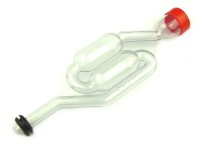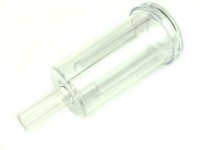Which fermentation vessel is right for me?
All brewmasters know: No beer without fermentation! This makes the choice of the optimal fermentation container all the more important. A number of questions arise: Plastic or stainless steel? Which size is the right one? And what else do I need to consider when buying? The endless selection of variants quickly overwhelms beginners in particular, and suddenly you've invested a lot of money in unsuitable equipment. How annoying! To help you find the right fermentation container right away, we'll give you a crash course here and answer your most important questions.
What does the fermentation tank do?
This is where the main fermentation happens: yeast converts sugar into alcohol and turns your brew into highly potent young beer, which is then allowed to mature extensively! Once this process starts, you can't stop it or reverse it. Therefore, the choice of the right fermenter is of high relevance for the quality of your beer. But what exactly happens in the fermenter? To find out, we need to take a closer look at the chemical equation of fermentation. In highly simplified terms:
Glucose + Yeast = Ethanol + CO2
The yeast gains its energy from the sugar and we are happy about the alcohol that is produced as a by-product. A win-win situation for both sides. Important in fermentation: the absence of oxygen. This forces the yeast to switch its metabolism rather than simply breathing oxygen. As a result, fermentation runs more smoothly overall. It is therefore no wonder that the so-called open fermentation tanks have been replaced by closed systems as technology has progressed
The fermentation tank must therefore keep oxygen away from your brew on the one hand, and on the other hand divert the resulting carbon dioxide (CO2) to prevent overpressure. This is done by means of a tight-fitting lid and an integrated fermentation tube or bung. Simply fill with water and the CO2 will escape without unnecessary oxygen reaching your brew. This allows the alcohol content of your beer to develop optimally. An additional outlet tap facilitates the final draining of the wort.
Buying fermentation tanks - here's what you need to look out for!
Size: The size of the fermenter depends on the amount of beer you expect to produce. For 20 liters, a fermenter with 30 liters is absolutely sufficient. As a rule of thumb, you can remember the two-thirds rule: No matter how big your fermenter is, never fill it more than 2/3 full. Then there will be enough space in any case.
Hygiene: A fermentation container must be easy to clean. Therefore, it should have a large opening at the top, so that you can easily reach everywhere with your arm plus brush. In any case, make sure that the material used is food safe. Therefore, an old paint bucket will not be considered as a fermentation container
Heatability: You want to use top-fermenting yeasts even in winter? Then you need a fermentation vessel with heating. Conversely, bottom-fermenting yeasts in summer need a cooled environment. Since the topic of temperature control is a very detailed one, we have dedicated an entire section to it. There you will learn how to best solve this challenge for yourself
How can the fermentation tank be heated?
Direct heating:Here, you simply hook a standard heating rod directly into the fermenter. The built-in thermostat reliably maintains the temperature once it has been set. Heating rods are very inexpensive to purchase. However, they have one disadvantage that should not be overlooked: they are rarely made of food-safe material. Therefore, make sure to disinfect them thoroughly before letting them come into contact with your precious beer! You'll also need to take care of routing the cable into your fermenter in an airtight manner, which takes a bit of ingenuity
Indirect heating: Here, the entire fermenter is heated from the outside. There are basically two ways to do this: Either you use a climate cabinet, where the complete fermenter is simply placed inside. This variant is cost-intensive and requires a lot of space, which not every hobby brewer has available. Or you can work with a heating foil/heating mat that is placed around the fermenter from the outside. Because of the heat conductivity, this works best with a stainless steel fermenter.
Cooling fermentation tanks - 3 variants
- Glycol Cooler: The high-end solution for big money, but also unbeatably convenient: just connect the tank, set the desired temperature and you're done. Requires a lot of space, however, and rather something for outside your own four walls, e.g. in a brewing cellar.
- External cooling: Analogous to indirect heating, you can also cool your beer with a climatic cabinet or insulating mat
- Accompanying cooler: cooling coil and pump. There are wet and dry versions here.
Stainless steel vs. plastic fermenters
This question divides the minds and you will hear many opinions in the hobby brewer scene. To help you make the right purchase decision, we will now show you the advantages and disadvantages of stainless steel and plastic fermenters.
Plastic fermenters - the lightweights
Lightweight and inexpensive. Two arguments that clearly speak for a fermentation container made of plastic. This makes them ideal for newcomers to the brewing scene. These lightweights are available from as little as 3 L filling volume
Plastic fermenters are relatively easy to clean, although you should always treat them gently. If you approach the matter with a wire brush and muscular grease, the plastic fermentation vessels are quickly scratched. This provides a wonderful breeding ground for bacteria that you definitely don't want in your beer.
However, plastic fermenters can also become deformed if they repeatedly come into contact with 60 °C hot wort. This is particularly the case with extremely inexpensive products. There are rumors in the brewing scene (and actually always when it comes to plastic) about substances dissolved out of the plastic, which then accumulate in the beer. Therefore, pay attention to the specified temperature resistance
Go for a plastic fermenter if you are:
- are just starting to brew beer.
- have only a small budget.
- need several smaller containers for experiments.
- don't need precise temperature control.
- prefer a low weight of your fermenter.
Stainless steel fermenters - the top class
Sustainable and hygienic. If you value these two characteristics, you're on the safe side with a stainless steel fermenter. And the high-quality look is on top of it. These fermenters are robust when it comes to cleaning. Scratches or the like are not to be expected. When it comes to bottoms, you have a choice of three variants: conventional stainless steel fermenters with straight or slightly curved bottoms, as well as a high-end solution with a conical bottom
Stainless steel fermenters come in larger fill volumes and usually have integrated temperature control and other helpful features. This is also reflected in the price, which is many times higher than the plastic version. Buying a used stainless steel fermenter can therefore be an alternative. The higher weight is also a factor that should be taken into account when deciding to buy
The stainless steel fermenter is ideal for you if you:
- already have some homebrewing experience.
- want to make your hobby more convenient and professional.
- want to brew your beer regardless of the season.
How do I clean my fermenter?
Immediately after you have removed the mash, you should clean your fermenter thoroughly. Trisodium phosphate and warm water are your tools of choice to reliably remove all brewing residues from plastic. Not at hand right now? Then water + soap + brush are a sensible alternative. Finally, rinse your fermenter with plenty of clean water and place it upside down to dry
Buy fermentation container? Enjoy the full selection in our store!
Now you know and nothing stands in the way of your freshly fermented young beer. In our store you will discover a wide range of fermenters: from slim to voluminous and simple to complex, our models are waiting to enrich your hobby brewery!












